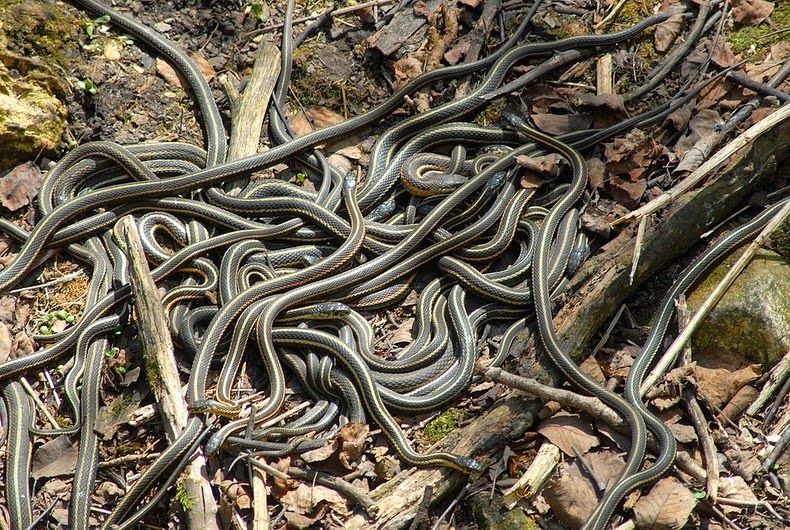he Narcisse Snake Pits are located 6 km north of the rural settlement of Narcisse in the province of Manitoba in Canada. These pits harbour the largest concentration of Red-sided Garter Snakes in the world. During winter, the snakes hibernate inside subterranean caverns formed by the area's water-worn limestone bedrock. Shortly after the snow melts in late April and early May, tens of thousands of these snakes slip out of their limestone dens and hang out on the surface of the ground performing their mating rituals in great tangled heaps.

The male snakes are usually the first to awaken from the long winter hibernation and reach the surface where they wait patiently for the females to come out. As the females slither out of the caves, the males pounce on the helpless females eager to mate with them. As many as 50 or more males attack a single female forming a writhing, moving “mating ball” of snakes. These massive snake balls are everywhere - on ledges, tree limbs, on plants and on the ground. Some mating balls slowly roll down rocks like tangled balls of twine. Professor Mason, a professor of zoology from Oregon State University estimated that there were 35,000 snakes at one pit alone and more than 250,000 in the general area.
There are four active snake dens at the Narcisse Wildlife Management Area. The dens are connected by a three-kilometer self-guiding interpretive trail. Tourists come from all over the world to view this spectacle from observation platforms built next to the dens, as do many scientists to study these non-venomous creatures.
The population of red-sided garter snakes around Narcisse was roughly 70,000 until terrible weather in 1999 killed tens of thousands of them before they could reach their winter dens. This tragedy triggered concern about the snakes' biannual migratory path, which cuts right across Highway 17. Every year, ten thousand snakes trying to get to or from their winter dens had been crushed under the wheels of vehicles. This had not been a problem before, because the vast population compensated for the losses. After the winter of 1999, however, the population of garter snakes was dangerously low, causing Manitoba Hydro and volunteers to intervene.
Foot-high snow fences were built to force snakes into 15-cm tunnels that went under Highway 17. Since some snakes still managed to squeeze under the fence and onto the road, signs were put up during the migratory season urging motorists to slow down to avoid accidentally driving over snakes. These measures worked, and now less than a thousand snakes per season are killed on the highway.





No comments:
Post a Comment